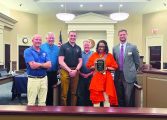By Page H. Gifford
Correspondent
 Sharon Harrigan never meant to write a memoir. She had just finished her MFA in creative writing and decided she needed a blog. She wasn’t sure what to write about since she wasn’t an expert in anything and began by writing about her life. A blog post about her father’s death got so much response that she turned it into an essay.
Sharon Harrigan never meant to write a memoir. She had just finished her MFA in creative writing and decided she needed a blog. She wasn’t sure what to write about since she wasn’t an expert in anything and began by writing about her life. A blog post about her father’s death got so much response that she turned it into an essay.
“It got so much response that people told me it needed to grow into a book,” said Harrigan, whose current book Playing with Dynamite: A Memoir, talks about her father, who blew off his hand with dynamite before she was born. As strange as that is, Harrigan’s father, an intelligent man but troubled, died mysteriously when she was seven. This prompted her to search for answers regarding her father’s death.
She began piecing the story together with family members, beginning with her mother, who told her everything she knew. Harrigan then set out to find out what even her mother didn’t know and Harrigan wasn’t sure she wanted to know but needed to find out. This was the emotional part of her journey.
From a technical perspective, she had a voluminous amount of material, sometimes repetitive and digressive, and turned it into a tight, cohesive narrative. She taped recorded interviews with her aunt and uncle that amounted to 300 double-spaced pages of transcripts. She believes this section alone was about 60 pages in the finished book and had to decide what to omit.
“I had to find the structure for the book, what kind of “container” to put these stories in. I decided to make my present-time story (2012-2014) chronological and to allow the stories from the past to emerge naturally as they are triggered by things happening in the present,” said Harrigan. “When I talk to my students about this kind of structure, I use the analogy of a clothesline. The present story is the line, and the past story is the clothes hanging from the line. Structurally, I also decided to allow the reader to discover things at the same time I discovered them, to follow me collecting clues, like in a detective story.”
Since memoirs are all about memories, constructing them is challenging when trusting one’s memories or that of others.
“I know people who have amazing memories—my brother, for instance, has a photographic memory. I am not one of those people. So remembering was hard for me. So hard, that my not remembering (and why I didn’t remember) became part of the story,” she said. “It was also hard to write the parts that didn’t come from my memory, that is, the parts that came from interviews. There was a lot of talking, and I needed to figure out a way to break up that talking with action and with scenes.”
Harrigan said the biggest challenge was emotional—the feeling that people were going to be mad at her.
“Asking difficult questions was scary, but I survived the experience. I was afraid of betraying people in my family by bringing up things that were not talked about, but the experience has brought us closer,” she said. “I realized that in some ways my brain had been stuck at age 7, understanding death in the magical-thinking way children often do. Finding out the real story allowed me to get past that.”
Harrigan said she went looking for her father but found her mother instead. She realized that her obsession with her father’s mysterious and bizarre story had eclipsed her mother’s presence in the story.
“She was the one who picks up the pieces, a single parent with three small grief-stricken children—she is the impressive one. I realized that we as a society are obsessed with the stories of big, powerful men, but it’s the resilient and reliable women, women who sometimes think they’re invisible—these are the fascinating stories that can teach us how to survive.”
She admits that writing a memoir is hard—both emotionally and technically. She tells her students not to worry too much about the structure of their memoir while they’re writing it.
“It’s best to mine your memory and collect all the stories and scenes that are vivid and have dramatic, emotional resonance. Then, after you’ve amassed a lot of material, you can decide what to keep and what kind of structure your story needs to glue it all together.”
An award-winning freelance writer, journalist, and editor, with a B.A. in English from Columbia and an MFA from Pacific University, she has been teaching memoir writing since 2012 and believes we all have a story to tell.
“We might not want to publish it or even show it to anyone else, but we all have lived through dramatic moments and survived them. (Memoir writer) Debra Gwartney says that the unwritten subtitle of every memoir is ‘how I coped.’ She also says that the plot of every memoir is ‘the narrator changed,’ who is usually the writer’s younger self. The writing self, the older self knows more than that younger self did and uses that wisdom to analyze and reflect on what happened and what it meant.”
“The most powerful memoirs are the ones that feel universal. We’re reading about the specifics of one person’s experience—and the more precise the details are, the more vivid it is—but we can see our own experiences reflected in theirs.” She adds that a memoir as a genre sometimes gets criticized for being “self-absorbed,” but doesn’t think that’s fair. “Good memoirs, like good novels, teach us something we didn’t know about the world, about the human experience, about trauma perhaps, but also about love and joy and redemption. And good memoirs also have a compelling plot that keeps you turning the pages.”
Harrigan gives some tips to would-be memoir writers.
“My advice is to start small. Write about an object or photo that has emotional meaning for you. Draw a picture of the house you grew up in. Close your eyes and imagine what it felt like to be in your favorite place, the place where you most felt like yourself. Imagine what it looked like, sounded like, smelled like. Allow yourself to inhabit that space again. Let the memories come. Invite them in.”
Harrigan also adds for those who are serious about writing a memoir she suggests the following authors: Bill Roorbach’s Writing Life Stories, Tristine Rainer’s Your Life as Story, and Melanie Brooks’ Writing Hard Stories. She recommends starting with Roorbach, which features lots of great exercises to help remember things and write scenes about them. Rainer’s book helps with the next stage, finding a structure and polishing the work. Brooks’ book is full of interviews with memoir writers about how they handled the emotional side of writing about traumatic events.
Sharon Harrigan will be the guest speaker at Friends of the Library monthly meeting on October 2, at 7 p.m. at the Fluvanna County Library.




